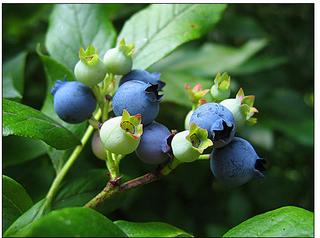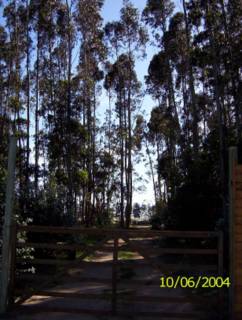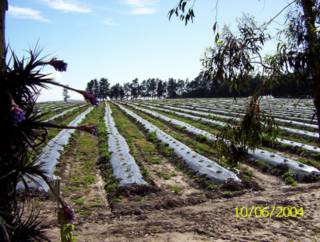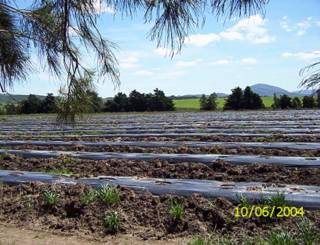Blueberries Las Garzas
de Punta del Este / Uruguay - - - - - - e-mail: berrypde@yahoo.com..CON SUMA NATURALEZA - CON SUMA SALUD !!!!
10.12.06
12.10.06
19.5.05
Blueberries Las Garzas
Dirección: Ruta Interbalneárea km. 106,2
Punta del Este - Uruguay
Teléfono: 0410 2666 desde todo el Uruguay
+(598) 410 2666 desde el exterior
18.5.05
21.3.05
Proyecto
Este es un proyecto de inversión nuevo en zona de Laguna del Sauce.
La idea es producir arándanos para exportación que dejan una ganancia muy buena por hectarea. Entre 30.000 y 80.000 dolares por ha. todos los años y por un período de mas de 20 años.
Esta idea empieza con la formacion de un primer lote de muestra, con la idea de ir sumando inversores que quieran armar alianzas estratégicas, y/o que no tengan posibilidad de hacer un proyecto por si mismos, ya sea por no tener el capital suficiente o por no tener tiempo para cuidar de las plantas.
COMO INVERTIR
Dependiendo del capital disponible Ud. puede optar por varias posibilidades:
1. Plantar una o varias hectáreas en su propia tierra.
2. Nosotros le arrendamos tierra, con opción a compra, para una o mas hectáreas.
3. Comprar accciones dentro de nuestro emprendimiento.
A continuacion una breve descripcion de cada posibilidad:
1. Plante en su propia tierra
Los técnicos de Las Garzas hacen un proyecto a medida de sus posibilidades y teniendo en cuenta las condicionantes de su propiedad.
Una vez aceptada la propuesta, se firma un contrato con las condiciones pactadas. Los servicios que se pueden contratar juntos o separados :
Asesoramiento técnico
Proyecto de viabilidad económica
Implantación
Cuidado pos implantación
Cosecha
Comercialización
2.
Nosotros le arrendamos por un plazo de 15 años un lote de acuerdo a su proyecto, esto es si Ud. proyecta tener 10 has. , pero comienza por escalonar la inversión en p.ej.: 2,3 y 5 has, para que Ud. tenga todo en una misma parcela, arrienda 13 has de tierra - 3 has para camineria interna aprox.- y se plantan el primer año 2 has., el segundo 3 has. y el tercero las 5 restantes.
Con esta opción Ud. accede:
a) al negocio del arándano sin tener que comprar tierra y dedicar el máximo del capital a las plantas de arándano, que en definitiva son las que le van a reportar las ganancias.
b) no necesita invertir en infraestructura, como p.ej.: galpón, tractores, herramientas, vivienda, instalaciones eléctricas onerosas, sistemas de bombeo de agua y demás infraestructura necesarias y que son comunes a todo el proyecto. Ud. solo dedica capital al arándano.
c) al integrar un proyecto de gran escala, accede en forma económica a la tecnología mas reciente y al mejor asesoramiento internacional, ya que el costo de los mismos se prorratea entre toda la superficie plantada.
d) si ud. decide comprar la tierra, es libre de usarla como Ud. disponga, y por ejemplo usar la misma con fines recreativos, como construir una casa de fin de semana.
3.
Compra de acciones
Actualmente tenemos a disposión inmediata la posibilidad de invertir en acciones de la plantacion realizada en el año 2004.
Ventajas:
Ud. accede al negocio del arándano con poco capital.
No se ocupa de la administración.
Cada acción tendrá un retorno calculado de U$S 4.000 con las actuales variables de mercado.
En breve seguiremos completando esta pagina, gracias.
Valor de fruta promedio
año | 2007 | 2008 | 2009 | 2010 | 2011 | 2012 | 2013 | 2014 | 2015 | 2016 | 2017 | 2018 | 2019 |
u$s x acción | 1.000 | 1.800 | 3.000 | 4.000 | 4.000 | 4.000 | 4.000 | 4.000 | 4.000 | 4.000 | 4.000 | 4.000 | 4.000 |
NOTICIAS DE PRENSA
02/02 - Durante el 2004 los envíos crecieron 100% en divisas y 67 % en volumen con respecto a 2003.
Durante el 2004 la certificación de exportaciones de frutillas, arándanos y frambuesas alcanzó las 8.449 toneladas por un valor de 22.992.000 dólares, un incremento del 67 por ciento en volumen y del 100 por ciento en divisas con respecto al año 2003 cuando los envíos sumaron 5.054 toneladas y 11.545.000 dólares, informó hoy el Servicio Nacional de Sanidad y Calidad Agroalimentaria (SENASA).
El principal producto exportado en volumen fue la frutilla con envíos de 6.824 toneladas por un valor de 6.644.000 dólares, mostrando un importante incremento del 63 por ciento en volumen y del 60 por ciento en divisas, respecto a 2003, cuando se registraron envíos por 4.183 toneladas y 4.163.000 dólares.
Los principales destinos para las frutillas de nuestro país fueron China, con envíos por 2.591 toneladas y 2.315.000 dólares; Estados Unidos 1.436 toneladas y 1.420.000 dólares y México, 1.194 toneladas y 1.196.000 dólares.También se registraron envíos de este producto a Canadá, 402 toneladas; Australia, 234 toneladas y Rusia 208 toneladas, entre otros.
En tanto la exportación de arándanos con envíos por 1.570 toneladas y 16.267.000 dólares, subió el 86 por ciento en volumen y el 121 por ciento en divisas con respecto a los envíos de 2003 que sumaron 845 toneladas y 7.356.000 dólares.
El principal mercado para este producto durante el año pasado fue Estados Unidos, hacia donde se registraron envíos por 1.051 toneladas y 10.508.000 dólares. También se certificaron envíos a Gran Bretaña, Holanda, Francia y España, entre otros.
Además se exportaron 55 toneladas de frambuesa por 81.000 dólares, mostrando un crecimiento del 111 por ciento en volumen y del 211 por ciento en divisas con respecto a las 26 toneladas por 26 mil dólares exportadas en 2003.
El principal mercado para este producto fue Gran Bretaña, hacia donde se registraron envíos por 32 toneladas y 38.000 dólares. También se exportaron frambuesas a Estados Unidos, Alemania y Francia.
Brief project description
The search
Chile is the greatest fruit exporter of the world since year 2005, Italy being the second. In Chile we have a friend who owns one of the most important companies of frozen fruit and other high value food goods for export. He recommended us to invest in Blueberries as it is safe and good investment with present and future perspective. He added that in the USA many people invest in blueberry farms for retirement. We researched for a year by travelling to Chile, Argentina, Uruguay and Spain to investigate everything related to the blueberry business . We visited about 70 blueberry producers, we got into contact with universities, professionals, plant nurseries, packing houses, exporters, forwarders, buyers, and so on.
Therefore, we have a viable business plan. In our case the IRR (Internal Revenue Rate) is over 70% at the least, and as regards current fruit price far over 100%.
Why Blueberries?
It is an off-season fruit for the fresh market. Its price is very good and the market demands have been increasing for the last years. The demand perspective is very positive and the price has stayed high for many years. We can say that there is a good price horizon for at least 10 years. Even if the price goes down because of the increasing fruit offer, the price floor is sufficiently good to take risk on such investment. That is why 10 years is time enough to payback the investment.
Blueberry cultivation maintenance does not give great problems. The plants live 40 or more years.
Blueberries are not affected easily by disease if handled correctly. We have seen failed projects because of poor preparatory preplantation work. For this, a good technician is crucial.
The care of the plants requires one worker every 1.5 hectare and during harvest time 20 or more.
As the fruit is affected by delayed frosts and possible hailstorms the location of he farm must be carefully chosen. We need to add that the quality and quantity of the water supply is a limiting factor for this plant.
Blueberries take from 5 to 7 years to grow, but the first small harvest occurs on the second or third season. In 2007 it is possible that the USA will allow our country to export blueberries there. Anyway, our country has already exported small fruit amounts to Europe at good price and quality success. Most of the harvest can be sold at the producers farm, bought in situ by forwarder companies.
What is much more interesting yet is getting a direct client. Forwarder companies get the same profit as producers, but without any investment risks. We are making contacts with Europe, mainly Germany, and they are interested in making deals with small fruit amounts and if all the conditions are granted establishing a regular commerce.
Why Uruguay?
The Uruguayan tax system is very advantageous for blueberry growers:
The fruit has no export taxes as in Argentina (10%).
The workers total costs are the lowest of the MERCOSUR countries.
In case the Uruguayan government changes the laws or/and taxes, investors have the possibility to export through the various TAX Free Zones of Uruguay. It is possible to invest thruough a so called Anonymous Society which is an anonymous share holder company .
Being Uruguayan tax system the lowest of the region it turns the country into the most competitive and ideal for this type of investment because if the fruit price goes down to a loss point and force our competitors to get out of market, we will still be gaining a respectable profit.Uruguay seems to be a very good and competitive market player.Uruguay has from good to very good conditions for growing blueberries.
What do blueberries need to grow?
1) Light and acid grounds.
2) If the ground is not the ideal it is possible to be improved with amendments and chemistries.
3) Very good water quality. This is an important project limitant.
4) Little wind conditions. This is a problem to be solved in most of the cases because Uruguay is a windy country.
5) Delayed frosts that affect the fruit. The plant requires cold temperatures below 7 Celsius degrees, according to the planted variety (in our case, 200 to 400 hours).
6) It needs full sun.
7)Fertilization is simple and inexpensive.
The blueberry business in numbers.
Investment for one hectare: between 25,000 and 35,000 US dollars. The investment falls if the planted area is greater than 5 ha.
Necessary infrastructure: it depends on the project, but in general about 40,000 to 70.000 US dollars. You need a barn, a house, a tractor and so on.
Cost of maintenance by hectare: 10.000 US dollars annually, all inclusive. The greater the project, the lower the costs. Investment scale seems to be a good idea, but it involves a big capital effort.
2006 season sale prices before taxes: 12 to 19 dollars for one kilo
The minimum economic unit we have studied is about 10 hectares. With 25 hectares or more you become an independent player.
The plants have to be bought one year before plantation, with a down payment of at least 30% as there are no plants in the market.The plants come from Argentina, Chile, the USA and now Uruguay.
The average of production by hectare in Argentina is of 6,000 kilos or more for early varieties.
The average production by hectare for technically well done projects is between 8,000 and 12,000 kilos. We have record of a production of 18,000 kilos in Chile, and 15.000 kilos in Tucuman/Argentina.
On our farm ee estimate that we will be having about 10,000 kilos of fruit per year, after 5 or 6 years as the plants are growing fast and strong.
The project
After making a deep analysis of all the Uruguayan territory, we reached to the conclusion of choosing the zone of Laguna del Sauce, the land strait between the lake and the ocean. Being between two water surfaces assures the optimal (mild) climate for the plantation. We have also 3 types of water, we reach here 60 meters above sea level and the land is a former farm of citrics. We are located along the so called ruta Interbalnearia We own a 6 hectare farm with 14,000 imported plants from Argentina that were planted in August 2004.
The verified growth of the plants is very good. Since we have had so many tourists visiting our farm and getting really interested in investing in blueberries , we got to the conclusion we should offer them good investment opportunities by offering planted lots, shares or plants in pots.
Our company plants the blueberries on a keyturn basis and offers to take care of the lots.
We are looking for joint-venture partners for this service business. The total investment will be about 200,000 US dollars. We are ready to sell up to 50% of our actual company for U$S 8.000 each share (1%) Each share will return between $2.500 and $ 4.500 dollars each year after two or three years.
Guía de cuidados
- Guía de cuidados para plantas de maceta
Si hace falta:
Fumigar contra hongos en forma rotativa. Nunca usar el mismo producto dos veces seguidas.
Fumigar contra plagas con Cipermetrina, cuando se noten ataques serios.
No fertilizar con Nitratos, pues son tóxicos para estas plantas. Usar sulfato de amonio o urea como opción, para aporte de nitrógeno. También es necesario el aporte de fósforo, el ideal es ácido fosforico. Algun fertilizante foliar (Nitrofosca) de vez en cuando para aportar micro nutrientes o fertilizantes orgánicos. Si no consigue éstos fertilizantes en plaza, nosotros se lo podemos vender fraccionado.
Cuidar que no haya sodio en el agua de riego, ni sales en general. Usar agua de lluvia. Si es agua de canilla, ésta tiene cloro (el cloro es para matar plantas como algas). Deje evaporar el cloro antes de regar, en un balde al sol. Lo mejor es dejar el balde lleno después de regar, así en el próximo riego ya se evaporó el cloro.
Las plantas necesitan: - Sustrato ideal con pH 4,8. No use humus de lombriz, por que tienen en general Ph alto.
- Mantillo de pino y mulch de pinocha . El Mulch es una capa de pinocha que se coloca tapando la maceta pero sin tapar el cuello de la planta, para que no sea atacada por hongos. El mulch mantiene húmeda la tierra. Irle agregando mulch a medida que éste se descomponga.
- Maceta de boca grande . Las mejores macetas son aquellas de barro y con una boca lo mas grande posible, de 60 u 80 cm de diámetro o mas aún. Esta maceta es la que alojará a la planta durante toda su vida (mas de 20 años), así que la plantita parecerá diminuta en semejante macetón. Coloque la maceta en el lugar correcto (al sol pleno y al reparo del viento). Recuerde que al elegir el lugar, tener en cuenta de que estas plantas se ponen de un color rojo muy bonito en el otoño. Fijarse que la maceta tenga buen drenaje (tal vez sea buena idea poner la maceta sobre un colchón grueso de pedregullo o cascotes).
- Agua de riego de lluvia es la ideal. Como no siempre se puede regar con agua de lluvia, dejar agua de canilla en un balde por varios dias, así se evapora el cloro.
- Siempre debe estar bien húmeda, sin estar inundada.
- Mucho sol.
- Reparadas del Viento.
- Poda apical poscosecha.
- Poda de rejuvenecimiento por tercios.
- No fertilizar demasiado.
- Fumigaciones preventivas solo si son necesarias.
- No carpir la maceta. Sacarle los yuyos a mano.
- Las plantas de arándanos producen mas fruta si están en compañía de otra planta de una variedad distinta (polinización cruzada).
- Si no encuentra los fertilizantes, nosotros se lo podemos vender fraccionado.
- Cualquier pregunta no dude en llamarnos o mandarnos un mail.
Recuerde: Con buena voluntad Ud. probablemente matará a su planta. Debe darle lo que ésta necesita, ni mas ni menos. En general todo lo que va para las azaleas, le va para los arándanos.
Con Suma Naturaleza
Con Suma Salud!
19.11.04
18.10.04
17.10.04
16.10.04
10.10.04
18.9.04
19.5.04
Datos de Mercado
A continuacion los precios de mercado, con la explicacion de como leerlos. Mas abajo los precios de mercado para las fechas en que nosotros exportamos, o sea noviembre y diciembre. en Noviembre el precio por kilo en Atlanta alcanza los 30,66 dolares por kilo!!
Extracto de mercado mayorista de Atlanta , en rojo los precios de arandanos (blueberries por "flat" o sea por bandeja, que tiene 12 "cups" (envase con tapa, de plastico, listo para llevar por el consumidor final) de 4,4 onzas cada uno. Fl es el precio mayorista de Florida y GA es el de Georgia. Estos precios son los del dia 18 de mayo, o sea que son los de primavera del hemisferio norte, donde la producción está arrancando fuerte. En el extracto se lee que la oferta es aun LIGHT o sea liviana, o poca oferta. Los precios irán bajando a medida que avance la temporada hasta agosto o setiembre, donde ya no hay producción local y es cuando empieza a entrar el hemisferio sur, con su oferta y a precios "top".
Una Onza son 28,35 gramos o sea que: 12 x 4,4 x 28,35 = 1.496,88 gramos. O sea 1,5 kilos aprox. Eso nos da al día de esta publicación un precio de 27,50 dólares promedio por "flat", un precio por kilo de 18,33 dolares por kilo, precio mayorista.
ATLANTA Terminal Prices as of 18-OCT-2005
BLUEBERRIES: OFFERINGS LIGHT. flats 12 4.4-oz cups with lids AG med 54.75 !!!!!
ATLANTA Terminal Prices as of 18-MAY-2005 Provided by: Fruit and Vegetable Market News, Federal-State Market News Service, USDA. Phone: (404) 361-1376 Fax: (404) 363-2523 AJ_FV010WEATHER AT 7:00 A.M. Partly Cloudy 61 YESTERDAY'S HIGH: 79 BERRIES---BLUEBERRIES: OFFERINGS LIGHT. flats 12 4.4-oz cups with lids FL med26.50-28.50 GA med 25.50-27.00 ---MISC BERRIES: OFFERINGS LIGHT. flats 12 5.6-oz cups with lids MXBlackberries 21.00-22.00 occas lower---RASPBERRIES: OFFERINGS LIGHT. flats 12 6-oz cups with lids CA Red lge26.50-29.00 occas lower Gold med few 17.50---STRAWBERRIES: MARKET ABOUT STEADY. flats 12 1-pt baskets CA med-lge16.00-17.00 one label 18.00 flats 8 1-lb containers with lids CA lge15.50-16.00 GA med-lge 14.00 flats 4 1-lb containers with lids CA With Stemsexlge 17.00-18.00 one label best 19.00-20.00
ATLANTA Terminal Prices as of 17-DEC-2004-BLUEBERRIES: OFFERINGS VERY LIGHT. flats 12 4.4-oz cups with lids AG AIR23.00-25.50 mostly 24.00-25.00
ATLANTA Terminal Prices as of 14-DEC-2004-BLUEBERRIES: OFFERINGS VERY LIGHT. flats 12 4.4-oz cups with lids CL AIR23.00-25.50 mostly 24.00-25.00
ATLANTA Terminal Prices as of 30-NOV-2004-BLUEBERRIES: OFFERINGS VERY LIGHT. flats 12 4.4-oz cups with lids AG37.50-38.00 CL 30.00-30.50
ATLANTA Terminal Prices as of 15-NOV-2004-BLUEBERRIES: OFFERINGS LIGHT. flats 12 4.4-oz cups with lids AG 45.50-46.00
CL 42.00
ATLANTA Terminal Prices as of 12-NOV-2004-BLUEBERRIES: flats 12 4.4-oz cups with lids AG 45.50-46.00
ATLANTA Terminal Prices as of 01-NOV-2004-BLUEBERRIES: OFFERINGS VERY LIGHT. flats 12 4.4-oz cups with lids CA42.00-43.00
30.1.04
Blueberries from Argentina shipped to the USA, quality test
From:
Sent: 12/10/2004 6:00 PM
To: Bonnie
Subject: Blue Review
Bonnie,
Got the blues! Thanks! Much better arrival than the first shipment a few weeks ago. Here's our review, I've ranked them in order by preference. I had about 10 different experts evaluate the berries and give me feedback. Can you give me prices and availability timeframes for the 3 top choices? Maybe we can offer them around next Christmastime.
#1 Tie Blue Cuinex grower Villa Elisa
Very good flavor and sweet, berries had nice color and size. Better texture than Blue Ship. Tied with Blue Ship for #1.
#1 Tie Blue Ship grower Villa Elisa Good blueberry flavor and sweet, nice color and berries had good size, good texture but the Blue Cuinex still had the best texture. Flavor was a little bit musty or spicy. Tied with Blue Cuinex for #1.
#2 Reveille growers Villa Eliza and Jose Ozafran
Very sweet and excellent dark blue color. Good sized berries but texture
was on the soft side. Jose's berries seemed a little better and firmer than Villa Eliza's.
#3 Misty grower Roberto Gurovich
Immature tasting and tart with a few red berries. Flavor not very strong. Small sized berries.
#4 Blue Crop grower Roberto Gurovich
Appeared very immature, lots of red berries and lots of variability in size of berries. Very tart to eat.
#5 Brigita grower Jose Ozafran
No blueberry flavor, bland, doesn't wow you. Lots of bloom with
good color. Small to medium sized berries.
#6 Bonita grower Jose Ozafran
Very sour tasting and berries seemed very firm. Excellent blue color withlots of bloom. It would be hard to tell if the berries were immature by visual appearance. Good size berries with a little bit of russet or
scarring.
Talk with you soon.
Lawna
30.6.00
Blueberries and the Brain
Blueberries and the Brain
Parents didn't know just how smart they were when they urged children down through the years to eat their fruits and vegetables. Hidden away in the various fruits and vegetables that are so abundant at this time of year are more than just vitamins, minerals and fibre. There are also polyphenolics, a range of compounds that, because of their antioxidant properties, protect the body against the impact of aging.
Human aging is like automobile rusting. Over time, oxygen interacts with chemicals in the body in a process called oxidation. The many biomolecules in the cells of our bodies are damaged by oxidation, just like the metal in our cars oxidizes, rusts, and degrades.
Oxidative damage to the DNA, lipids, enzymes and other cellular components in our bodies leads to various degenerative diseases and is at the heart of the aging process itself.
However, dietary antioxidants, like the polyphenolics found in blueberries, appear to slow down aging by providing protection against oxidative damage. Since blueberries have a very high antioxidant capacity compared to many fruits and vegetables, excitement has been building around the health properties of blueberries. Studies have shown that half a cup of blueberries can produce noticeable changes in antioxidant capacity in the blood, which peak roughly two hours after consumption.
This fall, food chemist Dr. Willy Kalt will continue to focus her research on antioxidant-rich blueberries and to determine how the polyphenolics in these fruit can protect against the body's natural aging process and against certain degenerative diseases such as stroke and Alzheimer's Disease. Kalt was invited to a blueberry health research symposium in Bar Harbour, Maine, this summer to talk about her recent research with the University of Prince Edward Island that looked at the damage to neurons after stroke in rats fed a diet high in blueberries.
"After stroke was induced under anesthetic, the damage to neurons in the brains of the rats fed a high blueberry diet was significantly less than in the rats not receiving blueberries" said Kalt.
These findings also support studies at the Center for Human Nutrition and Aging at Tufts University in the United States that indicated that a diet rich in antioxidants can reduce the effects of brain aging. Researchers from Tufts University showed that rats fed a diet high in antioxidants appeared to have better memory and improved motor skills compared to their counterparts who received a normal diet. Elderly rats fed blueberry diets even recovered some memory and motor abilities lost as a result of normal brain aging.
Also this fall, Dr. Kalt will be focusing on which specific types of polyphenolics in blueberries can protect against the body's natural aging process and in particular, brain aging. Kalt added that future studies will include how the polyphenolics get into the blood, how they are metabolized and how the compounds can be isolated and used in drugs. Other studies indicate that, like cranberries, blueberries protect the urinary tract against urinary tract infections.
"Typically the deeper the colour in the fruit or vegetable the more antioxidants are present and the greater the beneficial impact."

















